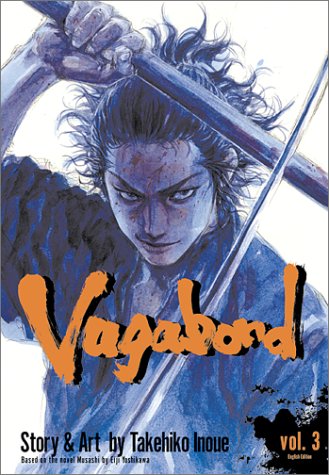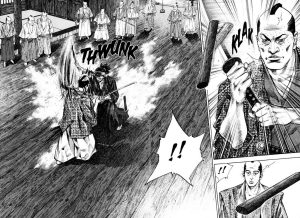Review by Karl Verhoven
Vagabond reaches a turning point in the fictionalised telling of Miyamoto Musashi’s life as this volume opens. Still known as Shinmen Takezō, in his youth he was a bit of a tearaway, but Vol. 2 ended with him forced to contemplate his past and see the error of his ways, and in the opening colour pages here he’s given the name under which his 17th century samurai exploits became known.
Takehiko Inoue’s narrative then jumps forward four years to Musashi in the city of Kyoto, where he’s immediately judged as a “country bumpkin who fancies himself a swordsman”. To be fair, Musashi cultivates the opinion with scruffy clothing and a wooden sword, but a challenge is a life and death matter as “it is the duty of a samurai to fight with the entirety of his heart and soul”. There’s a pleasing sequence where Musashi realises that despite being self-taught his skills are superior to the school-taught skills of his opponent, underestimation always being a joy of fiction.
Having amazed with the effort put into the small aspects of his artwork last time, Inoue here concentrates on swordsmanship, choreographing ever more deadly combat. It’s restrained storytelling with pauses, building toward a series of climaxes and counterpointed with the observations of an observer with a vested interest in what’s happening. That’s a great piece of storytelling as Inoue takes advantage of the four year leap.
In terms of whatever the greater plot may be, there’s not much propelling it forward here, but Inoue nonetheless sustains tension throughout. The reactions of observers are a little staged, but everything else works, building to one hell of a symbolic ending, and the consequences play out in Vol. 4.
This volume is combined with the previous two in opening VizBig edition, which cleans up the artwork a little, and is also easier to come by.





